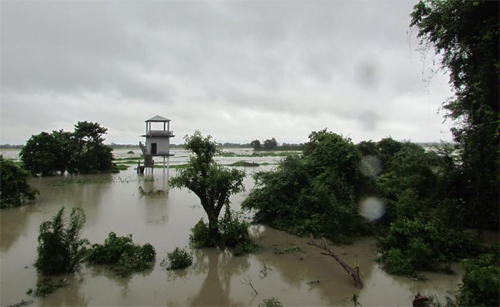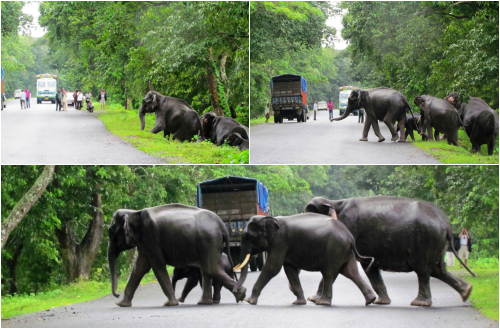Animals move to higher lands, as flood waters inundate Kaziranga National Park
Kaziranga National Park, August 17 2014: On constant vigil with the ongoing floods in Kaziranga National Park, the International Fund for Animal Welfare-Wildlife Trust of India (IFAW-WTI) run Centre for Wildlife Rehabilitation and Conservation (CWRC) is all set with a team of veterinarians, animal keepers, biologists and other conservationists to safeguard the affected animal population of the national park.
The water levels in the park are slowly increasing, with flood water from the Brahmaputra already covering all the low-grassland areas. The wildlife has started moving to higher lands looking for higher dry ground, as is their nature during the time of floods. A herd of elephants was seen crossing National Highway 37 (NH-37) on Friday afternoon towards the hills of Karbi Anglong, which is the usual path taken by wildlife moving towards the highlands.
Extra protection measures are needed to ensure the safety of the animals crossing the national highway. In previous years a number of hog deer and snakes lost their lives in road accidents as they attempted crossing the highway. The park authorities have increased patrolling on the roads and have installed temporary check gates in the vulnerable conduits and zones along with the national highway.
The Mobile Veterinary Service (MVS) team of CWRC has taken a stock of the flood situation during the last 48 hours, patrolling from the East to the West Ranges of Kaziranga National Park. The team is in constant touch with the Kaziranga Control, Park Directorate, DFO and the Range Officers with updated information to challenge any crisis on ground.
To mitigate the human –animal conflict during flood, the IFAW-WTI team has already organised flood awareness meetings in the fringe villages of Kaziranga and around the foothills of Karbi Anglong, where animals used to take shelter during flood. Local organisations like Seuj Yuba Sangha, Headmen of various villages as well as civil and forest authorities attended and briefed the villagers on to how to save the wildlife in crisis along with CWRC experts.

Flood waters in Kaziranga National Park on Independence Day 2014. Photo: Dr Rathin Barman / IFAW-WTI
CWRC has also prepared information bill-boards in Assamese (vernacular language) and handed it over to the village authorities to display in strategic locations for public information during the floods. Every banner has the emergency contact numbers of the centre and Kaziranga Control Room for immediate animal rescue intimation.
Though the CWRC team is on alert, no rescue call has been received till the filing of this story on Sunday (August 17, 2014) morning.










